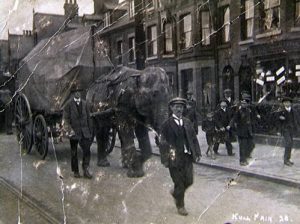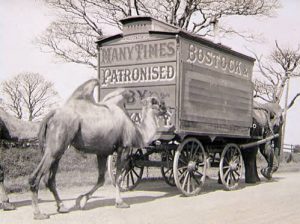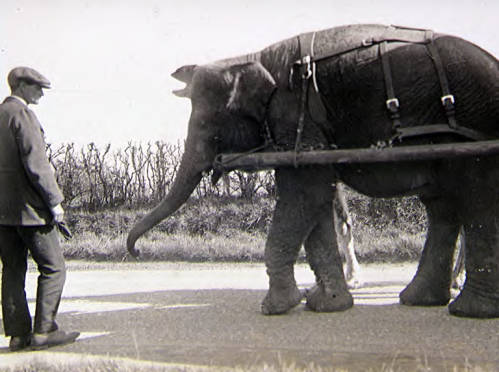Local legend has it that in 1891 an elephant was buried in Kingswood, South Gloucestershire. The elephant in question is said to have been an animal belonging to Bostock and Wombwell’s menagerie – a highlight in their travelling ‘beast show’.
As part of South Gloucestershire Council’s Kingswood regeneration project, archaeologists from Wessex Archaeology have been commissioned to conduct a geophysical survey to see if they can shine a light on the legend and identify the fabled burial site.
Tom Richardson, Terrestrial Geophysicists at Wessex Archaeology, said: “Searching for Victorian elephant burials isn’t our usual fare but a grave of that size would leave a large hole and would certainly be identifiable with the Ground Penetrating Radar equipment we will be using to survey the site. Watch this space!”
Councillor Chris Willmore, cabinet member with responsibility for planning, regeneration and infrastructure at South Gloucestershire Council, said: “Our work as part of the Kingswood regeneration project has presented us with a unique opportunity ahead of the high street pedestrianisation work. We’re excited to see what archaeologists may uncover and if we can finally solve this local mystery or find some new mysteries to solve.”
Bostock’s Star Menagerie is known to have exhibited nearby in 1891. Local newspapers reported that: “Bostock’s Grand Star Menagerie (No. 2 collection) will take up its quarters on Friday on the open space near Lawrence Hill station, where it will remain for 8 days…Among the larger animals in the collection is Nancy, a fine nine year old elephant, four camels, ten or a dozen fine lions and lionesses, three Bengal tigers, a sacred Indian bull, agnu [sic] or horned horse, some leopards, polar and brown bears, a hyena, and a pack of Russian wolves…The animals are all in splendid condition.” Bristol Mercury, 11 February 1891

Purported to have been buried in the area of Whitefield’s Tabernacle or Holy Trinity Church, the elephant is said to have died from yew leaf poisoning. Although no historical sources reference the death or burial of an elephant in the area, the Kingswood elephant is etched in local memory.
Alan Bryant, Curator at Kingswood Museum, said: “I first heard about the Kingswood elephant burial in the 1970s when I was doing my rounds as a local milkman. Since then, I have had countless conversations and debates with local people about it. I remember a new mains sewer pipe was installed in the 1980s and I made a point of having a look to see if there were any anomalies in the ground. Alas, nothing to report but I for one am delighted at the potential of discovering the legendary Kingswood Elephant burial.”
The long and infamous history of animal entertainment is well documented, from shows in Roman amphitheatres to Elizabethan bear-bating, but behind the spectacle of these shows the reality for the animals was often less glamourous. Menageries featuring wild and exotic animals were a fashionable form of entertainment throughout the Victorian era and early 20th century.
Dr Steve Ward, Circus Historian, said: “During the 19th century, the fascination with the natural world allowed both travelling and static menageries to flourish. People wanted to experience exotic and strange animals. Seeing these creatures was seen as educational, indeed the government actively encouraged families to take their children. But merely viewing them was not enough; the public also wanted to be entertained. In some menageries, animal keepers began to perform tricks with their beasts, especially with the large carnivores and elephants.”

Exotic animals were imported into the UK to join the animal exhibitions, performing circus acts and parading the streets to wow astonished crowds. The close relationship between animals and their handlers is well-documented but the conditions for animals in the Victorian entertainment industry would not have met modern welfare standards.
Lorrain Higbee, Zooarchaeologist at Wessex Archaeology, said: “This initial archaeological investigation aims to locate the elephant burial but should we do so, you may be surprised at what we could learn about the life of this animal from studying its skeletal remains.
“In the case of a menagerie elephant, as well as understanding where the animal came from and its age, we may be able to see the impact of its life as an entertainer, this may include evidence of confinement including trauma from shackling the animal or arthritis. It may also be possible to detect injuries or strains resulting from its performance duties, such as repetitive movements.”
There are various accounts of elephant burials around the country, including Diss in Norfolk, Coleshill in Warwickshire and Sleaford in Lincolnshire. Although many of these are considered urban myths, a geophysical survey at Diss did identify underground patterns that supported the claim.
The archaeological investigation to identify the burial of the Kingswood elephant is due to take place in July 2023.









